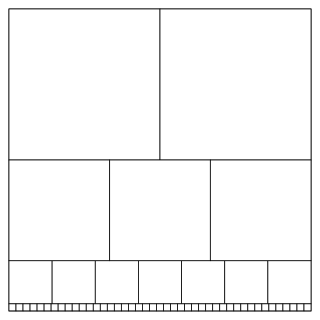
The number e, also known as Euler's number, is a mathematical constant approximately equal to 2.71828 that can be characterized in many ways. It is the base of the natural logarithms. It is the limit of (1 + 1/n)n as n approaches infinity, an expression that arises in the study of compound interest. It can also be calculated as the sum of the infinite series
In complex analysis, an entire function, also called an integral function, is a complex-valued function that is holomorphic on the whole complex plane. Typical examples of entire functions are polynomials and the exponential function, and any finite sums, products and compositions of these, such as the trigonometric functions sine and cosine and their hyperbolic counterparts sinh and cosh, as well as derivatives and integrals of entire functions such as the error function. If an entire function f(z) has a root at w, then f(z) / (z − w), taking the limit value at w, is an entire function. On the other hand, the natural logarithm, the reciprocal function, and the square root are all not entire functions, nor can they be continued analytically to an entire function.
In mathematics, the factorial of a non-negative integer , denoted by , is the product of all positive integers less than or equal to . The factorial of also equals the product of with the next smaller factorial:

In mathematics, the gamma function is one commonly used extension of the factorial function to complex numbers. The gamma function is defined for all complex numbers except the non-positive integers. For every positive integer n,
In mathematics, the prime number theorem (PNT) describes the asymptotic distribution of the prime numbers among the positive integers. It formalizes the intuitive idea that primes become less common as they become larger by precisely quantifying the rate at which this occurs. The theorem was proved independently by Jacques Hadamard and Charles Jean de la Vallée Poussin in 1896 using ideas introduced by Bernhard Riemann.
In mathematics, a transcendental number is a number that is not algebraic—that is, not the root of a non-zero polynomial of finite degree with rational coefficients. The best known transcendental numbers are π and e.
In number theory, a Liouville number is a real number x with the property that, for every positive integer n, there exists a pair of integers with q > 1 such that

Euler's constant is a mathematical constant usually denoted by the lowercase Greek letter gamma.
The Erdős–Borwein constant is the sum of the reciprocals of the Mersenne numbers. It is named after Paul Erdős and Peter Borwein.

The number e was introduced by Jacob Bernoulli in 1683. More than half a century later, Euler, who had been a student of Jacob's younger brother Johann, proved that e is irrational; that is, that it cannot be expressed as the quotient of two integers.
In number theory, Aleksandr Yakovlevich Khinchin proved that for almost all real numbers x, coefficients ai of the continued fraction expansion of x have a finite geometric mean that is independent of the value of x and is known as Khinchin's constant.
In mathematics, a Pisot–Vijayaraghavan number, also called simply a Pisot number or a PV number, is a real algebraic integer greater than 1, all of whose Galois conjugates are less than 1 in absolute value. These numbers were discovered by Axel Thue in 1912 and rediscovered by G. H. Hardy in 1919 within the context of diophantine approximation. They became widely known after the publication of Charles Pisot's dissertation in 1938. They also occur in the uniqueness problem for Fourier series. Tirukkannapuram Vijayaraghavan and Raphael Salem continued their study in the 1940s. Salem numbers are a closely related set of numbers.
In mathematics, the Champernowne constantC10 is a transcendental real constant whose decimal expansion has important properties. It is named after economist and mathematician D. G. Champernowne, who published it as an undergraduate in 1933.

Transcendental number theory is a branch of number theory that investigates transcendental numbers, in both qualitative and quantitative ways.
In mathematics, Apéry's constant is the sum of the reciprocals of the positive cubes. That is, it is defined as the number
Euclid's theorem is a fundamental statement in number theory that asserts that there are infinitely many prime numbers. It was first proved by Euclid in his work Elements. There are several proofs of the theorem.

In number theory, Sylvester's sequence is an integer sequence in which each term is the product of the previous terms, plus one. The first few terms of the sequence are
In additive combinatorics and number theory, a subset A of an abelian group G is said to be sum-free if the sumset A + A is disjoint from A. In other words, A is sum-free if the equation has no solution with .
In number theory, a Sidon sequence is a sequence of natural numbers in which all pairwise sums are different. Sidon sequences are also called Sidon sets; they are named after the Hungarian mathematician Simon Sidon, who introduced the concept in his investigations of Fourier series.
















